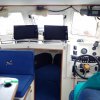Roger that on the value of the new Doppler technologies available in radar for the rec fleet, BCI
Don't want to de-rail OP's thread but my magic "wish I had Doppler radar" moment came last summer: pea-soup in the middle of Queen Charlotte Strait: A boat (target) comes up alongside me, approx. 30 meters off my port beam, then for some reason backs down to match my speed...there's sea room but I have to maintain course and speed because there are several reefs and rock spikes up ahead I've been watching on the screen and my charts.....then all of a sudden instead of two targets ahead (reef and rock spike which I'm threading between) there are now three targets. I immediately start calculating tides: is that another rock that an ebb tide exposed??? My hands are starting to sweat. NO, tide is high so it has to be a boat that just threaded through the same passage I'm heading for from the opposite direction (it's a well-travelled nav route between PT. Hardy and Cape Caution)
But which target is rock, which is reef, and which is boat? And meanwhile I have a big red blob off my port beam who's gotten closer: he's obviously trying to thread the same narrow passage as I am.....now my heart is pounding ---I see a distinct potential for 4 targets all converging in a very tight spot in the middle of pea soup fog, as dense as any fog I've ever see...it was definitely high-stress---I boat alone so you're sitting there making all these split-second calculations, completely at the mercy of your electronics and charts, not to mention dodging branches and logs mixed up in the waves that you absolutely have to side-step as they would take out a propeller fluke lickety split if you hit one...
My one logical thought at that point: how valuable Doppler radar would have been in that instance. Instant situational awareness of your boat in relation to radar targets: green going away from you (with a directional trail), red coming towards you (with a directional trail) and constant color with no trail if it's a rock or an island....
Pardon the mention of the word "idiot" in the Doppler diagram....that would be me for not stepping up earlier for the technology....
View attachment 42403






